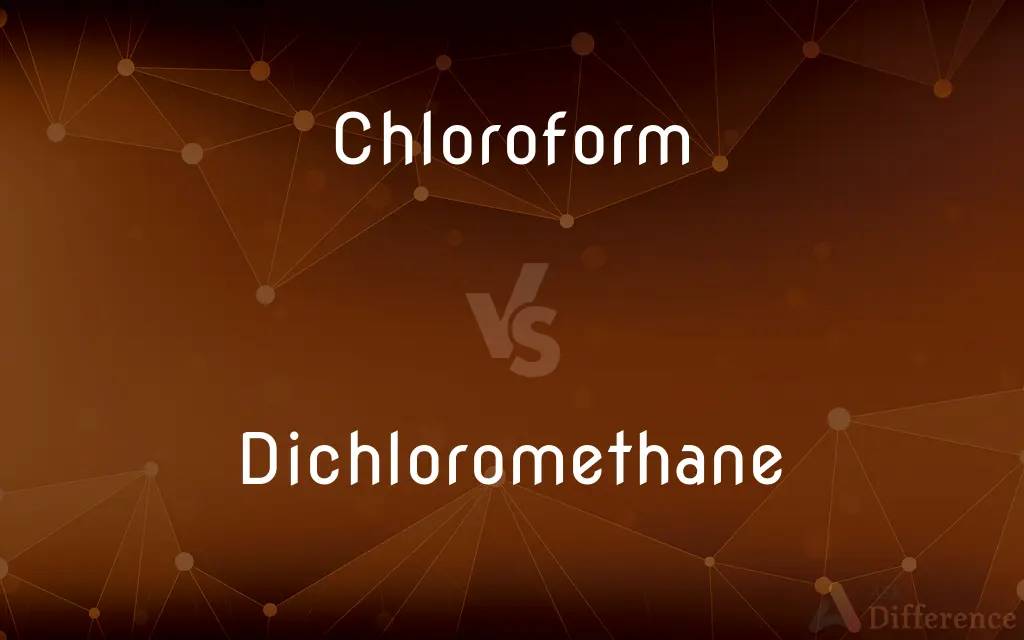Chloroform vs. Dichloromethane — What's the Difference?
Edited by Tayyaba Rehman — By Fiza Rafique — Updated on October 5, 2023
Chloroform (CHCl₃) is a trihalogenated organic compound, historically used as an anesthetic, while dichloromethane (CH₂Cl₂) is a dihalogenated organic solvent commonly used in labs and industry.

Difference Between Chloroform and Dichloromethane
Table of Contents
ADVERTISEMENT
Key Differences
Chloroform, with the chemical formula CHCl₃, has three chlorine atoms attached to a single carbon. It was once a popular anesthetic but is now mainly used in labs and industrial applications. Dichloromethane, CH₂Cl₂, has two chlorine atoms, and is a versatile solvent employed in various industrial processes and lab procedures.
Chloroform gained historical significance when it was used as an anesthetic during surgeries and childbirth. However, due to its adverse effects, its medical use was discontinued. Dichloromethane doesn't share this medical history and has predominantly been utilized as a solvent, especially for organic compounds.
Both Chloroform and Dichloromethane are clear, volatile liquids at room temperature. However, they have different boiling points, with chloroform boiling at around 61.2°C and dichloromethane boiling at 39.6°C.
Prolonged exposure to Chloroform can have adverse effects on the liver, kidneys, and central nervous system. Dichloromethane, on the other hand, can act as a potential carcinogen and depressant of the central nervous system.
Both compounds can contribute to air pollution when released into the atmosphere. Notably, Chloroform can deplete the ozone layer, though its atmospheric concentration has reduced due to regulatory measures. Dichloromethane's contribution to ozone depletion is lesser but still significant.
ADVERTISEMENT
Comparison Chart
Chemical Formula
CHCl₃
CH₂Cl₂
Historical Use
Previously used as an anesthetic.
Primarily used as a solvent.
Number of Chlorines
Three
Two
Boiling Point
Approx. 61.2°C
Approx. 39.6°C
Health Risks
Can affect liver, kidneys, and CNS.
Potential carcinogen; affects CNS.
Compare with Definitions
Chloroform
Historically used as an anesthetic.
Chloroform revolutionized surgeries in the 19th century.
Dichloromethane
Widely used in paint removers and degreasers.
This paint stripper contains dichloromethane for quick action.
Chloroform
A volatile organic compound with three chlorine atoms.
She detected the distinct sweet smell of chloroform in the lab.
Dichloromethane
A dihalogenated methane derivative.
The molecule of dichloromethane has two chlorine atoms attached to a carbon.
Chloroform
A trihalogenated methane derivative.
The structure of chloroform includes a central carbon bonded to three chlorines.
Dichloromethane
A clear volatile liquid with a sweet aroma.
The lab was filled with the scent of evaporating dichloromethane.
Chloroform
A compound with potential health risks upon exposure.
Handling chloroform requires safety precautions due to its potential toxicity.
Dichloromethane
A potential carcinogen with health implications.
It's essential to use gloves when working with dichloromethane due to its harmful effects.
Chloroform
A clear liquid used in industrial and laboratory applications.
Chloroform is often employed in the extraction of specific organic substances.
Dichloromethane
An organic solvent with two chlorine atoms.
Dichloromethane effectively dissolved the organic compound in the mixture.
Chloroform
Chloroform, or trichloromethane, is an organic compound with formula CHCl3. It is a colorless, strong-smelling, dense liquid that is produced on a large scale as a precursor to PTFE. It is also a precursor to various refrigerants.
Dichloromethane
Dichloromethane (DCM or methylene chloride) is an organochloride compound with the formula CH2Cl2. This colorless, volatile liquid with a chloroform-like, sweet odour is widely used as a solvent.
Chloroform
A clear, colorless, dense, sweet-smelling liquid, CHCl3, used in refrigerants, propellants, and resins, as a solvent, and sometimes as an anesthetic. Chloroform, once widely used in human and veterinary surgery, has generally been replaced by less toxic, more easily controlled agents.
Dichloromethane
(organic compound) The partially halogenated hydrocarbon CH2Cl2 widely used as a solvent
Chloroform
To treat with chloroform to anesthetize, render unconscious, or kill.
Dichloromethane
A nonflammable liquid used as a solvent and paint remover and refrigerant
Chloroform
To apply chloroform to.
Chloroform
(organic compound) A halogenated hydrocarbon, trichloromethane, CHCl3; it is a volatile, sweet-smelling liquid, used extensively as a solvent and formerly as an anesthetic.
Chloroform
To treat with chloroform, or to render unconscious with chloroform.
Chloroform
A colorless volatile liquid, CHCl3, having an ethereal odor and a sweetish taste, formed by treating alcohol with chlorine and an alkali. It is a powerful solvent of wax, resin, etc., and is extensively used to produce anæsthesia in surgical operations; also externally, to alleviate pain.
Chloroform
To treat with chloroform, or to place under its influence.
Chloroform
A volatile liquid haloform (CHCl3); formerly used as an anesthetic;
Chloroform was the first inhalation anesthetic
Chloroform
Anesthetize with chloroform;
Doctors used to put people under by chloroforming them
Common Curiosities
Why is dichloromethane a popular solvent?
Its ability to dissolve a wide range of organic compounds makes it versatile in labs and industry.
How should one handle dichloromethane?
With caution, using proper protective equipment and working in well-ventilated areas.
Are they flammable?
Dichloromethane is slightly flammable, while chloroform's flammability is very low.
Can they be mixed with water?
Both are not miscible with water but can form layers when mixed.
Is chloroform still used as an anesthetic?
No, chloroform's use as an anesthetic was discontinued due to safety concerns.
Is chloroform naturally occurring?
In small amounts, yes. It can form in the environment through biological processes.
Which is denser, chloroform or dichloromethane?
Chloroform is denser than dichloromethane.
How are they produced industrially?
Both are produced through the chlorination of methane.
Can dichloromethane be used for extractions in organic chemistry?
Yes, it's a common solvent for extractions due to its properties.
Is dichloromethane harmful if ingested?
Yes, it can be toxic and should not be ingested.
Were there any famous incidents involving chloroform?
Historically, chloroform was associated with crime stories as a "knock-out" agent, though its actual efficacy in this regard is debated.
How should spills of chloroform be handled?
With caution, using protective gear and ensuring proper ventilation, then absorbing and disposing of according to regulations.
Is dichloromethane denser than water?
Yes, it's denser and will form a layer below water when mixed.
Are there alternatives to dichloromethane in labs?
Yes, solvents like acetone or ethyl acetate can sometimes be used as alternatives.
Why is chloroform's use restricted in many countries?
Due to its health and environmental impacts, especially its role in ozone depletion.
Share Your Discovery

Previous Comparison
Applause vs. Ovation
Next Comparison
Horizon vs. SkylineAuthor Spotlight
Written by
Fiza RafiqueFiza Rafique is a skilled content writer at AskDifference.com, where she meticulously refines and enhances written pieces. Drawing from her vast editorial expertise, Fiza ensures clarity, accuracy, and precision in every article. Passionate about language, she continually seeks to elevate the quality of content for readers worldwide.
Edited by
Tayyaba RehmanTayyaba Rehman is a distinguished writer, currently serving as a primary contributor to askdifference.com. As a researcher in semantics and etymology, Tayyaba's passion for the complexity of languages and their distinctions has found a perfect home on the platform. Tayyaba delves into the intricacies of language, distinguishing between commonly confused words and phrases, thereby providing clarity for readers worldwide.
















































